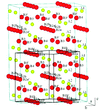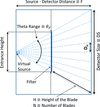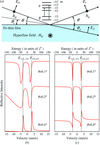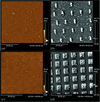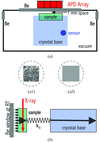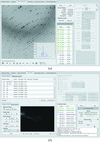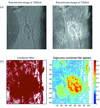issue contents
March 2012 issue

Cover illustration: Pole figures depicting the angular change of lattice plane normals for four applied deformations (see Poshadel, Dawson and Johnson, pages 237-244). These images illustrate how insufficient pole figure coverage introduces ambiguity between correct and other plausible deformation modes, which inherently limits component-wise resolution of the strain tensor.
facility information
research papers
An analysis of the stereochemistry of helium-cooled fluorescence XAFS data on ferrocene is presented, investigating the uncertainty of typical datasets and the information content.
A detailed description of the structural changes, charge disproportions and local anisotropies below the Verwey transition in magnetite is provided by means of resonant X-ray scattering data in high-quality single crystals and thin films grown on MgO.
A novel experimental technique for tandem mass spectrometry and ion spectroscopy of electrosprayed ions using vacuum-ultraviolet synchrotron radiation is presented.
A new method to determine the magnetic fields of undulator sources from their X-ray emission is presented.
The filter fluorescence or backscatter rejection capability and operational efficiency of Soller slits is determined for an arbitrary design depending on the number of slits, the size of the slits, and any misalignment from the intended focus point.
Based on the refraction by planar mosaic prism lenses, an X-ray monochromator with moderate bandpass and energy tunability has been proposed and tested.
Basic and application studies of grazing-incidence synchrotron-radiation 57Fe-Mössbauer spectroscopy using a nuclear Bragg monochromator are introduced. As a great advantage for surface and interface science, the developed method combined with the 57Fe-probe layer technique enables researchers to study the interface structure of thin films with atomic-scale depth resolution.
Direct observation of the NiPS active phase is discussed.
The ordered-subsets expectation maximization algorithm in X-ray fluorescence computed tomography allows image reconstruction with a large angular sampling interval but maintaining a high image quality.
A description of a new sputtering system for in situ X-ray experiments during DC and RF magnetron sputtering is given. First experimental results on vanadium carbide are presented.
Open  access
access
 access
accessMicrometre-size lateral magnetic modulations were fabricated in FeRh thin films by ion-microbeam irradiation. Their magnetic domain structures were characterized by XMCD–PEEM.
Open  access
access
 access
accessOptimized X-ray waveguides have been fabricated and characterized in terms of transmission, angular acceptance, farfield pattern and imaging applications. Beam confinement down to sub-10 nm in two orthogonal directions has been demonstrated, at the nano-focus endstation at P10 of PETRA III at HASYLAB/DESY.
An in situ loading experiment demonstrates differences in uncertainties among deviatoric lattice strain components measured using polychromatic X-ray microdiffraction. Monte Carlo simulations show that the differences in uncertainties are caused by spurious deformation modes that arise erroneously in the strain calculation owing to measurement noise and limited pole figure coverage.
The design of inexpensive high-resolution X-ray emission spectrometers that are portable and have high collection efficiencies is described. This methodology is illustrated by the construction and commissioning of an instrument for observing the Pr Lα emission spectrum during a high-pressure study in a diamond anvil cell.
The two-crystal-interferometer-based phase-contrast X-ray imaging technique enables in vivo hepatic vessel images of small animals to be visualized using only physiological saline and low X-ray dose.
Open  access
access
 access
accessThe real sample temperatures during the nuclear resonant vibrational spectroscopy on biological samples have been assessed and significantly reduced (116 → 52 K) by improving the sample-loading procedures.
Open  access
access
 access
accessThe effect of the X-ray dose on room-temperature time-resolved Laue data is discussed.
computer programs
MxDC and MxLIVE, software packages for macromolecular crystallography data acquisition and on-line experiment information management, are described.
Open  access
access
 access
accessA suite of GUI programs written in MATLAB for advanced data collection and analysis of full-field transmission X-ray microscopy data including mosaic imaging, tomography and XANES imaging is presented.
laboratory notes
A simple affordable rack for storing SPINE pucks is described, a solution which is accessible to both synchrotrons and research laboratories alike.
current events
Free 



 journal menu
journal menu



















